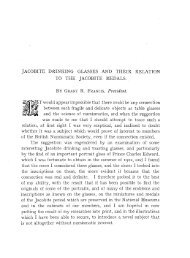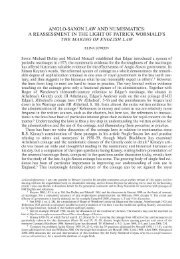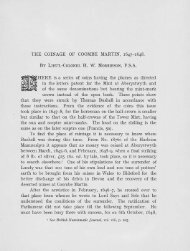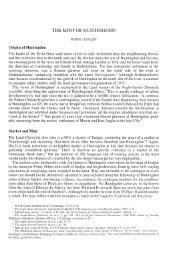The coins of the Ionian State
The coins of the Ionian State
The coins of the Ionian State
Create successful ePaper yourself
Turn your PDF publications into a flip-book with our unique Google optimized e-Paper software.
T H E C O I N S O F T H E I O N I A N S T A T E .<br />
BY NATHAN HEYWOOD.<br />
IN taking a retrospective view <strong>of</strong> <strong>the</strong> various rulers <strong>of</strong> this<br />
chain <strong>of</strong> islands, numbering about forty, <strong>the</strong> principal <strong>of</strong><br />
which are Corfu, Cephalonia, and Zante, it is not surprising<br />
that <strong>the</strong>re are several series <strong>of</strong> <strong>coins</strong>.<br />
It is, however, purposed only to describe in detail those pieces<br />
issued under <strong>the</strong> Russo-Turkish and <strong>the</strong> British Protectorates.<br />
On <strong>the</strong> division <strong>of</strong> <strong>the</strong> Roman Empire, <strong>the</strong>se islands were included<br />
in <strong>the</strong> eastern half. In A.D. 1081, Corfu and Cephalonia fell into <strong>the</strong><br />
hands <strong>of</strong> Robert Guiscard, and from that time <strong>the</strong>y had a chequered<br />
history for over three centuries.<br />
In <strong>the</strong> year 1401 Corfu came into possession <strong>of</strong> <strong>the</strong> Venetians,<br />
who afterwards acquired Zante and Cephalonia, and subsequently<br />
most <strong>of</strong> <strong>the</strong> o<strong>the</strong>r islands included in <strong>the</strong> group. <strong>The</strong> Venetians<br />
retained <strong>the</strong>m until 1797, when <strong>the</strong>y were ceded to France. During<br />
<strong>the</strong> Venetian occupation <strong>of</strong> <strong>the</strong> sixteenth and seventeenth centuries,<br />
<strong>coins</strong> were issued in copper having on <strong>the</strong> obverse a winged demi<br />
Venetian lion <strong>of</strong> St. Mark surrounded by <strong>the</strong> inscription : S. MARCVS<br />
VEN. II (for two quattrini), and on <strong>the</strong> reverse <strong>the</strong> names <strong>of</strong> <strong>the</strong> three<br />
principal islands (variously abbreviated 1 ). <strong>The</strong> islands were seized by<br />
Russia and Turkey in 1799, and <strong>the</strong>y were created by <strong>the</strong> Emperor<br />
Paul <strong>of</strong> Russia into a Septinsular Republic under <strong>the</strong> protection <strong>of</strong><br />
CORF. CEFAL. ZANT.<br />
(Plate I, Figure 1.)<br />
CORFV. CEFAL. ZANT.<br />
CORFV. CEFALONIA. ZANTE.<br />
CORF ZANT. CEF.<br />
CORFV. CEFALON. ZANTE.<br />
(Plate I, Figure 2.)<br />
CORFV. CEFAL. ZANTI.<br />
COR. CEFA. ZAN.<br />
CORF. CEFA. ZAN., 6tC., etc., etc.
<strong>The</strong> Coins <strong>of</strong> <strong>the</strong> <strong>Ionian</strong><br />
<strong>State</strong>.<br />
Turkey.<br />
•copper.<br />
<strong>The</strong> <strong>coins</strong> issued under <strong>the</strong> Russo-Turkish influence were <strong>of</strong><br />
1. Obverse.—A. winged demi Venetian lion holding in <strong>the</strong> dexter paw<br />
a sheaf <strong>of</strong> seven arrows, <strong>the</strong> sheaf ornamented with a cross,<br />
(Community <strong>of</strong> <strong>the</strong> Seven Islands) surrounded by <strong>the</strong> inscription :<br />
EnTANHZOZ nOAITEIA. Reverse. — 10 —<br />
TAZETAIZ 1801—in three lines within a circle <strong>of</strong> ovals.<br />
Edge engrailed with ovals. (Plate I, Fig. 3.)<br />
2. Obverse.—As No. 1. Reverse—5—rAZETAIZ—1801—in three<br />
lines, within a circle <strong>of</strong> ovals.<br />
3. Obverse.—As No. 2. Reverse.—As No. 2, ornamented with roses.<br />
(Plate I, Fig. 4.)<br />
4. Obverse.—As No. 3. Reverse.—1—rAZETA—1801, in three lines,<br />
within a circle <strong>of</strong> ovals. (Plate I, Fig. 5-)<br />
5. Obverse.—As No. 4. Reverse.—As No. 4. <strong>The</strong> figure 1 <strong>of</strong> <strong>the</strong><br />
value between two ovals. (British Museum.) (Plate I, Fig. 6.)<br />
6. Obverse.—As No. 5. Reverse.—-As No. 5, ornamented with roses.<br />
(Plate I, Fig. 7.)<br />
In 1807 <strong>the</strong> islands were given back to France by <strong>the</strong> treaty <strong>of</strong><br />
Tilsit.<br />
In 1809 Great Britain seized Zante, Cephalonia, and Cerigo ; in<br />
1810, Santa Maura; in 1814, Paxo ; and after <strong>the</strong> fall <strong>of</strong> Napoleon<br />
Buonaparte, Corfu, and on <strong>the</strong> 5th <strong>of</strong> November, 1815, <strong>the</strong>y formed<br />
<strong>the</strong> United <strong>State</strong>s <strong>of</strong> <strong>the</strong> <strong>Ionian</strong> Islands, under <strong>the</strong> Protectorate <strong>of</strong><br />
Great Britain.<br />
By <strong>the</strong> treaty <strong>of</strong> London <strong>the</strong> protectorate was incorporated in <strong>the</strong><br />
Kingdom <strong>of</strong> Greece on <strong>the</strong> 14th <strong>of</strong> November, 1863.<br />
<strong>The</strong> first issue consisted <strong>of</strong> <strong>the</strong> penny, halfpenny, and farthing in<br />
copper, and took place on <strong>the</strong> 4th <strong>of</strong> February, 1819. Bronze pro<strong>of</strong>s<br />
exist <strong>of</strong> each value <strong>of</strong> that year (Plate I, Figs. 8, 9, and 10), and<br />
copper pro<strong>of</strong>s <strong>of</strong> <strong>the</strong> obolus dated 1853, 1857, and 1862. <strong>The</strong><br />
farthing, or 2^ oboli, was fur<strong>the</strong>r issued in 1820 (Plate I, Fig. 11),<br />
and 1821. <strong>The</strong> obolus was issued in 1834 (Plate I, Fig. 13), 1835,<br />
1848, 1849, 1851, 1853, 1857, and 1862. <strong>The</strong> silver 30 oboli, or<br />
threepenny piece, was issued first on <strong>the</strong> 23rd <strong>of</strong> August, 1834<br />
(Plate I, Fig. 14), and in <strong>the</strong> years 1848, 1849, 1851, 1852, 1857, and<br />
1862 <strong>The</strong> silver <strong>coins</strong> weigh grains each. <strong>The</strong> copper pieces
COINS OF THE IONIAN STATE.<br />
PI.<br />
II.
<strong>The</strong> Coins <strong>of</strong> <strong>the</strong> <strong>Ionian</strong> <strong>State</strong>. 191<br />
liave on <strong>the</strong> obverse <strong>the</strong> winged lion <strong>of</strong> Saint Mark holding in <strong>the</strong><br />
o<br />
o<br />
dexter forepaw a sheaf <strong>of</strong> seven arrows, <strong>the</strong> sheaf ornamented with<br />
a cross surrounded by <strong>the</strong> inscription : ION IKON KPATOX (<strong>Ionian</strong><br />
<strong>State</strong>), and <strong>the</strong> date ; and 011 <strong>the</strong> reverse, except in <strong>the</strong> case <strong>of</strong> <strong>the</strong><br />
oboli, a figure <strong>of</strong> Britannia seated looking to <strong>the</strong> sinister, and holding<br />
an olive branch in her right hand and a trident in her left, surrounded<br />
by <strong>the</strong> inscription :—BRITANNIA.<br />
<strong>The</strong> farthing <strong>of</strong> 1821 is inscribed BRITANNIA, and has on <strong>the</strong><br />
reverse a seated figure <strong>of</strong> <strong>the</strong> goddess looking to <strong>the</strong> sinister,<br />
and resting on a shield, with <strong>the</strong> figure 4 (for quattrini) in <strong>the</strong> exergue.<br />
Mr. W. S. Churchill's specimen (Plate I, Fig. 12) is struck over<br />
a Venetian copper coin, as are probably all <strong>the</strong> farthings <strong>of</strong> that year.<br />
<strong>The</strong> oboli are inscribed BRITANNIA and have on <strong>the</strong> reverse<br />
a seated figure <strong>of</strong> <strong>the</strong> goddess looking to <strong>the</strong> dexter (Plate I, Fig. 13).<br />
<strong>The</strong> silver pieces have on <strong>the</strong> obverse within a wreath <strong>of</strong> oak leaves<br />
tied with a ribbon <strong>the</strong> figure 30 surrounded by <strong>the</strong> inscription:<br />
IONIKON KPATOX and <strong>the</strong> date <strong>of</strong> <strong>the</strong> year <strong>of</strong> issue, and on <strong>the</strong><br />
reverse a figure <strong>of</strong> <strong>the</strong> goddess seated looking to <strong>the</strong> dexter, resting<br />
her right hand on a shield and holding- a trident in her left ; above is<br />
<strong>the</strong> inscription :—BRITANNIA.<br />
<strong>The</strong>re are two mules in copper, one <strong>of</strong> <strong>the</strong> penny <strong>of</strong> 1819, with<br />
<strong>the</strong> obverse <strong>of</strong> <strong>the</strong> Irish penny <strong>of</strong> George IV., and <strong>the</strong> o<strong>the</strong>r <strong>of</strong> <strong>the</strong><br />
halfpenny <strong>of</strong> <strong>the</strong> same year, and <strong>the</strong> Ceylon stiver <strong>of</strong> George III.<br />
<strong>The</strong> beautiful silver and copper "phcenix" coinage issued in <strong>the</strong><br />
years 1828-1831 by <strong>the</strong> first government <strong>of</strong> independent Greece,<br />
under Count Ioannes Antonios Kapodistrias, a native <strong>of</strong> Corfu,<br />
circulated freely in <strong>the</strong> <strong>Ionian</strong> Islands. On <strong>the</strong> 9th <strong>of</strong> October, 1831,<br />
<strong>the</strong> Count was assassinated in a church at Nauplia, and, consequently,<br />
his coinage ceased.<br />
For illustrations <strong>of</strong> this coinage, see Plate II, Figs. 15 to 25.<br />
To commemorate <strong>the</strong> British Protectorate, <strong>the</strong> following medal<br />
was struck in silver and copper:—<br />
Obverse.—MDCCCXVII. Britannia seated looking to <strong>the</strong> sinister<br />
holding a shield <strong>of</strong> <strong>the</strong> Union Jack under <strong>the</strong> left hand, <strong>the</strong> right<br />
supporting a double tablet <strong>of</strong> constitutions in front; behind is
<strong>The</strong> Coins <strong>of</strong> <strong>the</strong> <strong>Ionian</strong><br />
<strong>State</strong>.<br />
a standing figure <strong>of</strong> Neptune on a pedestal holding a trident in<br />
front <strong>of</strong> an anchor.<br />
In <strong>the</strong> exergue, ENGLAND GIVES A CONSTITUTION TO—<br />
Reverse.—Seven draped female figures holding hands and standing<br />
round a standard from which <strong>the</strong> Union Jack is flying.<br />
DEPAULS F., in small letters.<br />
In <strong>the</strong> exergue, THE IONIENNE ISLANDS. MUDIE D, in small<br />
letters. Plate II, Fig. 26.<br />
My acknowledgments are clue to Mr. Herbert A. Grueber, F.S.A.,<br />
for kindly supplying me with casts <strong>of</strong> <strong>the</strong> Russo-Turkish <strong>coins</strong> in <strong>the</strong><br />
British Museum.



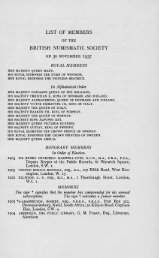

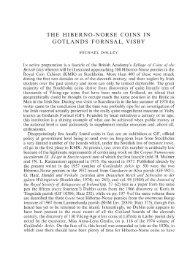
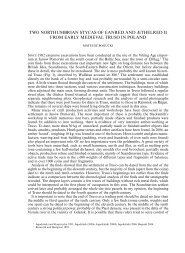

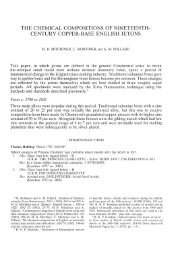
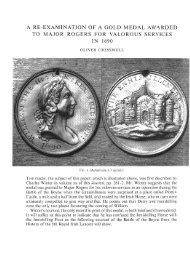
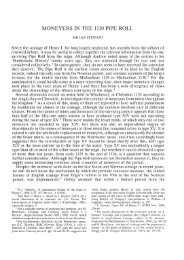
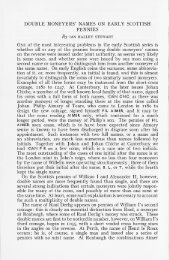
![Two Anglo-Saxon notes: [1] A Cnut die-link between the mints of ...](https://img.yumpu.com/15433998/1/189x260/two-anglo-saxon-notes-1-a-cnut-die-link-between-the-mints-of-.jpg?quality=85)
